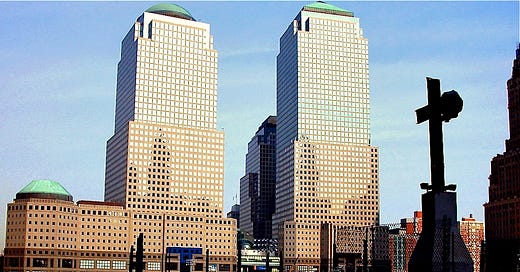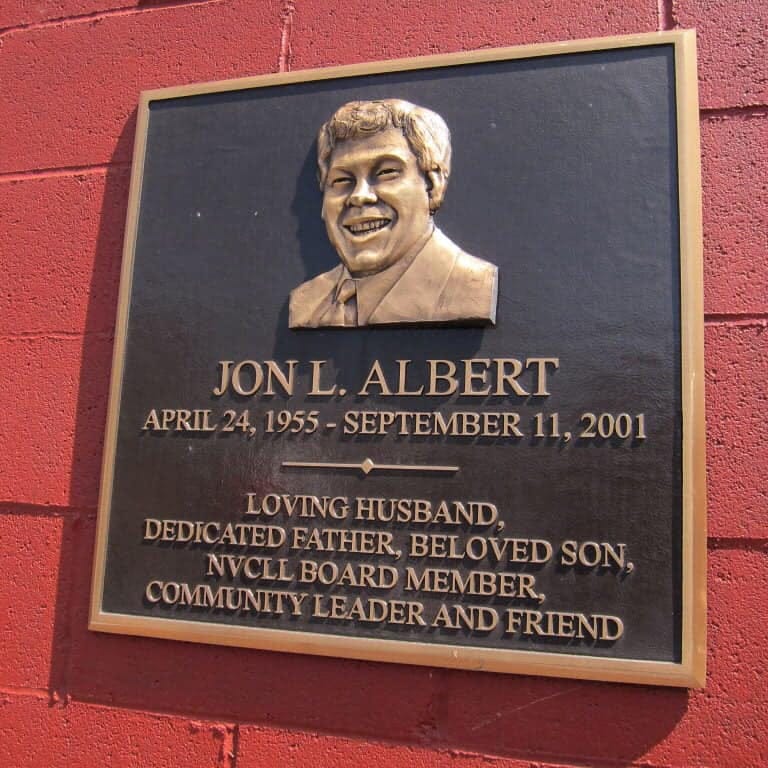That Day in New York: Losing a Friend on September 11
Fearing the worst while wandering Manhattan.
Most of us in the New York area have a “9/11 story.” Mine pales behind many others, but here it is. Compounding the tragedy, Bush lied the country into a murderous invasion of Iraq and then we stayed in Afghanistan for almost twenty years. But first, an odd, little-heard Leonard Cohen performance, “On That Day.” Feel free to share, comment or subscribe (it’s still free).
Twenty years ago tomorrow, at 8:15 in the morning, I boarded a Metro North train to New York, heading for my office in the East Village, where I served as the editor of venerable Editor & Publisher magazine. A few minutes later as my train sped south, an airliner flew almost directly overhead above the Hudson on its way to find and smash into one of the World Trade Center towers. Before our train reached Upper Manhattan, a conductor announced that a plane had hit the WTC. Surely this was a small plane, and an accident. I looked down the river and saw the smoke against a perfectly blue sky, recalling that one of my friends--we had chatted just the night before about our Little League team--worked in one of the towers.
Arriving at Grand Central, I headed for the TV sets (always turned to Fox News) mounted at the main newsstand off the concourse. There I learned that a second plane, an airliner like the first, had struck the other tower. So, not an accident. The subways were still running, but I could not move from in front of the TV.
It was in that news kiosk where I wordlessly watched the towers fall. Around me: a few screams, many tears, but mainly fear. My main thought was: “What floor does Jon Albert work on?” I recalled it as being horrendously high. I had coached his son Stephen for several years, and wrote about Jon and his boy in my then-current book, Joy in Mudville. In fact, I was coaching his son that month on my “fall ball” team, and his dad was one of my assistants.
After watching the next hour unfold on the screen, in horror, I tried to catch the last train out of Dodge, barely missed it, then joined the mass evacuation from the terminal after a voice on the P.A. announced a plane might be heading our way. I spent the next three hours in a sun-drenched daze, trying to reach the E & P office, more than thirty blocks south. I took a cab for a few blocks, then all traffic stopped. I walked back to Grand Central thinking the subways or trains might be running again. They weren’t. Found a pay phone to call home. Like other New Yorkers, I staggered around midtown for an hour, catching bits of news off TVs in bars and cafes. A persistent rumor: Another hijacked airliner might be heading our way.
Then I trudged straight downtown, toward the office, with smoke filling the sky beyond that and sirens crying everywhere. Rooms in every hotel were already taken. At one near Grammercy Park, three young people who had been catering an event in one of the towers tried unsuccessfully to book a room. They were ghost-like, partly covered in ash.
As I got below 14th Street, I could see more clearly the mountain of deadly smoke covering that patch of blue sky to the south that once embraced the towers. I was a veteran of ground zeroes, having spent time in Hiroshima and Nagasaki, but this was here, this was now. Swirls of acrid dust blew in my face—pulverized metal and (I imagined) human residue.
Well, I reached the office, and somehow, with the reliable Joe Strupp, getting some stories up on our website. When the trains started running again in the evening, I headed for home. There I learned that Jon Albert, who worked at Marsh-McLennan, had not yet returned, and everyone feared the worst. Also missing, and likely victim of the same fate, was the daughter of our neighbors directly across the street.
None of us from E & P could reach our office the next day, as everything south of 14th Street was sealed off, but many of us dodged the police lines 24 hours later to help get the next issue out, on time: a small miracle. To do it, we had to ignore the disturbing smells from outside that often filtered through our ventilation system. Our cover was all black with “September 11, 2001” in white type. My friend Jon Albert, and more than 2000 others, still hadn’t come home.
Two weeks later, I arranged for Jon’s two boys to attend a Mets game (he and they were rabid fans) as honored guests. I asked Mets officials to let them come down on the field, watch batting practice from behind the cage, talk with manager Bobby Valentine in the dugout, and meet some of the players in the clubhouse. They were all so kind. The boys even left with a swag bag. They still thought Dad was coming home. He never did, and the paperback edition of Joy in Mudville is now dedicated to him. So is the local Little League field. I would coach Stephen for the next two years, including on a Little League team that made the state finals, and he went on to become a star pitcher in high school. I’d write about his father again in my book about media coverage of the Iraq war, So Wrong for So Long.
Below, the tribute to Jon at the local Little League field, and my photo from 2002 as rebuilding at Ground Zero continued. And that’s my story.
Greg Mitchell is the author of a dozen books, including the bestseller The Tunnels (on escapes under the Berlin Wall), the current The Beginning or the End (on MGM’s wild atomic bomb movie), and The Campaign of the Century (on Upton Sinclair’s left-wing race for governor of California), which was recently picked by the Wall St. Journal as one of five greatest books ever about an election. His new film, Atomic Cover-up, is drawing extraordinary acclaim. For nearly all of the 1970s he was the #2 editor at the legendary Crawdaddy. Later he served as longtime editor of Editor & Publisher magazine. He recently co-produced a film about Beethoven’s Ninth Symphony.






More on my cousin: Wiki entry:
https://en.m.wikipedia.org/wiki/Daniel_Lewin
Daniel Mark Lewin (Hebrew: דניאל "דני" מארק לוין; May 14, 1970 – September 11, 2001), sometimes spelled Levin, was an American–Israeli mathematician and entrepreneur who co-founded internet company Akamai Technologies. A passenger on board American Airlines Flight 11, it is believed that Lewin was stabbed by one of the hijackers of that flight, and was the first person murdered during the course of the attacks.[1][2][3]
Daniel Lewin
Born
May 14, 1970
Denver, Colorado, U.S.
Died
September 11, 2001 (aged 31)
On board American Airlines Flight 11, approximately in the air over Worcester, Massachusetts, U.S.
Cause of death
Stabbing
Education
Technion – Israel Institute of Technology (BA, BS)
Massachusetts Institute of Technology
Occupation
Entrepreneur
Spouse(s)
Anne Lewin
Children
2
Military career
Allegiance
Israel
Service/branch
Sayeret Matkal
Rank
Captain
Good onya, Greg. I was in Cali watching on the tv but I heard later that my second cousin in Boston’s husband was on the DC-bound plane.
He was one of the passengers who tussled with the terrorists.
Kain y’Hi Razon